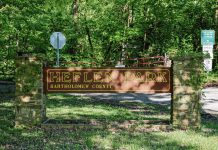The odds won’t favor drivers when more than double the number of trains begin traveling on the railroad line bisecting Columbus within two years.
Columbus Redevelopment Commission members got their first look at the potential impact on the city when American Structurepoint consultants Monday presented an analysis of how the increasing number of longer trains will affect residents and commuters.
And while commission members questioned a few of the consultant’s conclusions, John Dorenbusch, commission vice president and a member of the committee studying the issue, cautioned that the waits drivers experience now for trains at State Road 46 on the west side of downtown could double by 2018.
The northbound longer, faster and heavier CSX trains are expected to increase the current wait time at the State Road 46 crossing of about 13 minutes now for eastbound traffic to about 20 minutes in 2018 — and grow to 40-minute delays by 2036. Those times reflect what will happen if nothing is done to change the rail crossing configuration, the consultants said, describing the estimates as large and staggering.
[sc:text-divider text-divider-title=”Story continues below gallery” ]
The delays take into account increasing traffic projected for State Road 46 and the impact of having 22 longer trains a day passing through Columbus, compared to eight now.
American Structurepoint reviewed traffic counts at six railroad crossings in Columbus for its study: 11th Street, Eighth Street, Fifth Street, State Road 46, Spear Street and County Road 200S. Each of those crossings will be affected by the Louisville & Indiana Railroad’s plan to increase the number of trains by leasing the line to CSX Transportation.
City officials have learned that when CSX Transportation submitted its environmental assessment of the proposed changes in April 2015 to federal officials, their own assessment showed three crossings in Columbus ranked in the top five of daily vehicle delays — State Road 46 (top of the list), Eighth Street and 11th Street. That’s out of 154 intersections studied between Louisville and Indianapolis, and includes crossings in Seymour, Taylorsville, Edinburgh, Franklin and Greenwood.
However, Dorenbusch later questioned Columbus’ Eighth Street intersection being in the top five, as that is an entrance to Mill Race Park and not nearly as busy as State Road 46.
In addition to increasing the number of trains, the trains’ length will be longer, from 5,100 feet now to 7,500 feet. The trains will go from just single-stacked cars to double-stacked, the consultants said. The speed limit through Columbus will remain at 15 mph although it will increase up to 50 mph on other parts of the line as it heads to Indianapolis.
The consultants presented a traffic simulation video showing that other components of the State Road 46 crossing, including the traffic light and how vehicles line up at the intersection, as other reasons for the extended delays at that intersection beyond trains. The consultants included two intersections along State Road 46 — Johnson Boulevard and Carr Hill Road — in the study as they are feeder intersections into the line of vehicles that forms at the State Road 46 intersection when trains move through.
Allowing that many people are in a hurry to get to work and sometimes self-report longer wait times than actually occur, city officials said they wanted to warn the public now that no matter how the train delay is measured, it will be increasing.
“How bad is it going to be? We’ll know better in another 30 days,” Dorenbusch said of the ongoing study of the State Road 46 intersection. “There is some refinement that needs to be done with the numbers.”
Robert Abrams, a non-voting redevelopment commission member representing Bartholomew Consolidated School Corp., mentioned that school buses and parents who transport their students to school will feel the effects of the increased train traffic, particularly the increasing number of those attending Southside Elementary School on the southwest side of the city. However, all secondary schools will be affected by the change, he said.
Commenting about the lack of an official train schedule, Don Trapp, commission secretary, asked about the impact on police, firefighters and the hospital.
“If there is a delay of five minutes getting to the hospital, what will the impact of that be?” he asked.
Everyone has their own anecdotal story of experiences waiting for a train to clear at the State Road 46 intersection, Mayor Jim Lienhoop said.
The study puts some numbers to the actual wait times that can be used as part of a proposal to state and railroad officials about how the intersection needs to be improved, including the probability of needing to build an overpass at the State Road 46 crossing.
City officials are taking some measures now to mitigate the effect of the increased train traffic, redevelopment director Heather Pope said.
The city is considering establishing quiet zones to alleviate the noise of train horns, she said. Traffic stop arms at some of the other crossings are being considered for safety.
And city officials are consulting with county officials about improvements to Lowell Road, which may handle some of the westside drivers who want a back way into the city that avoids the State Road 46 intersection, Lienhoop said.
The increased train traffic will be delayed by a year as the railroad replaces the Flat Rock River Bridge, an estimated 100-year-old rail bridge that needs to be widened for today’s rail traffic and changed to allow the double-stacked rail cars the railroad plans to use, the consultants said.
City officials have had a meeting with the Indiana Department of Transportation about the State Road 46 intersection, as that highway is in the state’s jurisdiction, and the agency is aware the intersection is a problem and the city is getting its plan together, Lienhoop said.
American Structurepoint is now working on defining alternative solutions for the intersection, including the possibility of building an overpass over the railroad that will follow the path of State Road 46 to the bridges over the East Fork White River.
But even if the city had completed all of its study and convinced INDOT to move the State Road 46 project to the front of the line for a road improvement project earlier this year, the earliest any improvements could have been started would be 2020, Lienhoop said.
[sc:pullout-title pullout-title=”Railroad plans” ][sc:pullout-text-begin]
Rail traffic changes planned by CSX Transportation through Columbus include:
Number of trains per day now: 8
Number of trains per day proposed: 22
Rail intersections affected:
- State Road 46 (Listed as top intersection affected by traffic delays)
- Eighth Street (Listed in top five to be affected by traffic delays)
- 11th Street (Listed in top five to be affected by traffic delays)
- Fifth Street
- County Road 200S
- Spear Street
Number of rail intersections between Louisville and Indianapolis: 154
Increased train length: 5,100 feet to proposed 7,500 feet.
Increased car weight (total): 263,000 pounds to 286,000 pounds.
Increased car height: From single stack to double stack
Increased train speed: 15 mph limit will remain in Columbus but will increase to 50 mph outside the city limits.
[sc:pullout-text-end]




